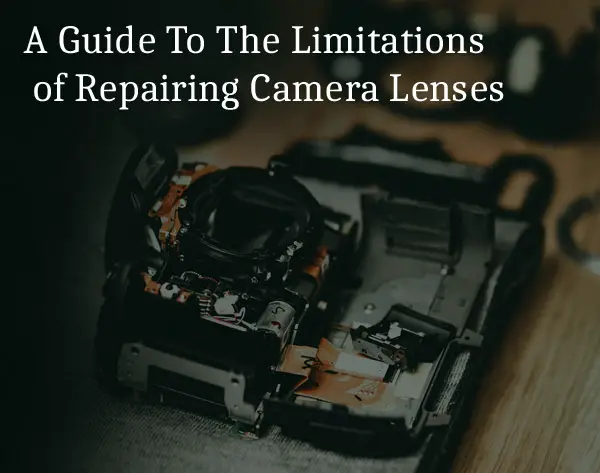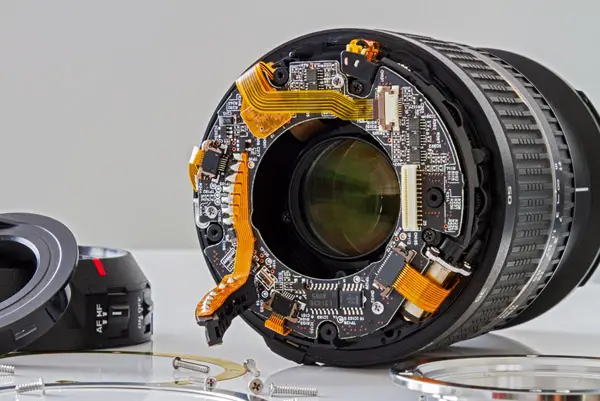There is one heart-stopping moment for every photographer.
It happens when the prized possession that they spent hundreds or thousands of dollars to buy falls to the ground.
If you’ve ever experienced it, you know the gut-wrenching agony and how the seconds feel like hours until you pick up your camera and begin to examine it. You know the cold chills of fear as you turn it over to see if the lens is okay…

What if the unthinkable has happened? Can you repair a camera lens? What are the limitations?
It really depends on the type of damage your lens sustained. Small scratches can be buffed out and replacing a cracked front element is doable. However, replacing elements or repairing internal damage is so expensive that in many cases it makes more sense to buy a new lens.
Let’s break it down and see when it might make sense to try to repair a lens and take a look at the limitations of repairing camera lenses.
Anatomy of a Camera Lens
First of all, let’s take a moment to understand the anatomy of a camera lens. With a good idea of how lenses are put together, you can better understand if the issue your lens is experiencing is fixable.
Your lens is made up of a lot more glass than you might realize. These pieces are used to bend light and focus the rays on specific points in order to take a sharp image.
How the pieces work together is very complex and we won’t go into all of it here. However, suffice it to say that people who design camera lenses are incredibly intelligent, especially the ones who create the impressive lenses we are seeing today. To learn a little more about what goes into building lenses, check out our post on why wide-angle lenses are so expensive.
The anatomy of a specific lens will vary according to the type of lens that it is. The number of elements and lens groups can vary quite a bit, but let’s just stick with a basic explanation for our purposes.
Elements and Lens Groups
Take a look at your lens. On the front, you’ll see a piece of glass that is called the front element. There is also one on the back inside the lens mount that is referred to as a rear element. Inside the lens, there can be several more lenses, some of which are fixed together. Single lenses are sometimes referred to as elements and lenses that are fixed together are usually called a lens group. When counting lens groups, a single element is considered a lens group as well.
For example, the Canon 70-200mm f/4L IS has 20 elements and 15 groups. This means there are 20 individual pieces of glass and some of them have been fixed together to form only 15 groups.
The number of elements and groups in a lens can vary significantly. More doesn’t always mean better because the more pieces of glass that are in the way, the more possibility for distortion and aberrations. The build quality of the lens is a stronger deciding factor.
What Should You Do When You Drop a Lens?
First off, relax and take a deep breath. Not every dropped lens is destroyed. First thing is to pick it up and see if there is any visible damage.
Examine the housing and check the front element for scratches or (God forbid) cracks or gouges. If it looks okay, that’s a good thing, but you’re not out of the woods yet.
The impact can disrupt the positioning of elements inside the lens, causing the focus to go off-center or other issues. Most optical problems severe enough to affect your images will be immediately noticeable when you take a few test photos.
To be extra sure, set up your camera on a tripod directly facing a brick wall. Take a few shots, paying particular attention to the corners and watching for distortion. To check that the diaphragm is still working, shoot the wall at different apertures, adjusting the shutter speed to compensate. If everything is working okay, the photo should come out exposed the same each time.
Try using all the moving parts to see if they still perform correctly. Activate the autofocus, use the manual focus, turn on the IS, fiddle with the aperture ring — whatever features your lens possesses, run through them all to see if they work.
If all that comes out okay, you can breathe a sigh of relief and tell your wallet to relax. Your camera lens survived the mishap.
Can You Repair Your Camera Lens?
What if your camera didn’t survive unscathed? Should you be preparing yourself for a hefty repair bill?
Not just yet. There are some types of lens damage that you may be able to repair yourself and at a lot lower cost. Keep in mind that, in general, even an easy fix at the repair shop will cost you a couple of hundred dollars so it is definitely worth your time to troubleshoot a bit on your own first.

Repairing a Scratched Front Element
What if the front element got scratched? It’s okay, this doesn’t always mean your lens is toast. Believe it or not, some scratches on the front element aren’t noticeable in the photos. Of course, others appear as a whitish smear or add a ghosting effect to the image. The effect is usually most noticeable at night, adding halos around lights or creating a strange brightish spot in the image.
Take a bunch of test photos in different lighting environments and of different backgrounds. Examine them closely to see if there are any noticeable effects of the scratch on the image quality.
If the scratch’s effect is noticeable, don’t worry, all is not yet lost. You may be able to buff out the scratch yourself.
Check out how The Virginia Stew removes scratches from camera lenses of all types in this video.
What If the Scratch Is Too Deep?
If the scratch is too deep to buff out, it’s probable that you’ll need to replace the front element. Unfortunately, while this sounds like it shouldn’t be an expensive fix, it is. Front elements can end up encompassing a quarter or even a third of the entire cost of the lens. Add to that the labor to replace it, and it often makes more sense to buy a new lens instead.
If you browse YouTube, you’ll find videos of people explaining how to replace a front element or make other repairs on a camera lens. It’s best to look for one for the specific lens you’re dealing with. If you feel inclined to buy a second-hand lens (broken in some other capacity so you can get a good price) for the part you need, you may be able to repair it yourself following the video.
However, keep in mind that the slightest mistake can result in more damage. Not to mention that the almost inevitable dust particle getting inside your lens may mess up the optical quality anyway. We only recommend this route if the lens is inoperable as is and you can get a cheap replacement part.
Repairing a Lens Mount
Sometimes the lens mount can get knocked out of whack when you drop the lens. Thankfully, replacing the lens mount is usually doable. It’s not a complicated repair and you may be able to do it yourself, plus a replacement lens mount typically isn’t expensive.
Here are instructions for how to replace the lens mount on a Nikon lens.
Can a Camera Lens Be Repaired?
You may have noticed that all the issues we’ve talked about here are relatively minor. If you’re staring at a lens with a broken piece of glass or with suspected internal damage, you’re still waiting for good news with a sinking feeling in your stomach. You’re beginning to suspect there isn’t an easy (i.e. inexpensive) solution to your problem.
Well, unfortunately, you’re right.
Remember what we talked about in the anatomy of a camera lens? There are just too many parts in there. Taking it apart and putting it back together is almost more work than building a whole new lens. Plus, all this work must be done in a special, dust-free environment to ensure no specks of dust get inside the lens.
All that said, the short answer is that yes, many types of lens repairs are possible. Unfortunately, they are often not practical or economically viable. It often turns out to be less expensive to buy a new lens than have your broken one professionally repaired. Even if repairing it is slightly cheaper, it may not be worth spending that money on an old lens. You might as well buy a new one (or a gently used one).
Where to Take Your Camera Lens to Be Repaired
If you’re not sure how expensive fixing your lens might be, take it to a repair shop. They will be able to give you an estimate of how much it will cost to fix the lens. From there, you can decide if you think it’s worth it.
However, be careful where you take your lens. Always take your equipment to a repair center authorized by your camera manufacturer. You’ll have a better chance of getting somebody who knows what they’re talking about. Plus, they may have parts on hand and may even offer a warranty on any work they do.
Repairing Your Camera Lens
If your camera lens has suffered a tragedy, first of all, let us mourn with you for a moment. We know what an awful feeling that can be when you see your thousand dollar lens take a tumble.
The good news is that in some cases the damage can be repaired and you might even be able to do it yourself.
Interested to learn more about how DSLR lenses work? Click the link.









1 comment